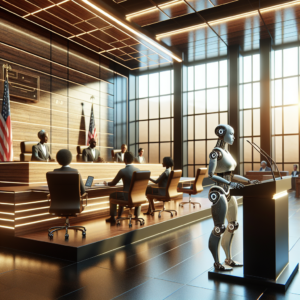AI ‘Hallucinations’ in Court Papers Spell Trouble for Lawyers
In recent years, the legal industry has witnessed a groundbreaking transformation with the integration of artificial intelligence (AI) into various processes. From document review to case prediction, AI has proven to be an invaluable asset. However, with the advent of AI-driven tools comes a new set of challenges, particularly the phenomenon known as ‘AI hallucinations.’ This refers to the unexpected and often erroneous outputs generated by AI systems, which can have serious implications when applied in legal contexts.
Understanding AI Hallucinations
AI hallucinations occur when machine learning models generate outputs that are not based on factual information. This can manifest in various ways, including the creation of completely fabricated data, incorrect citations, or even the misinterpretation of legal precedents. These inaccuracies can arise from a multitude of factors, including biased training data, insufficient context, or inherent limitations of the algorithms themselves.
As AI systems become more prevalent in the legal field, the risks associated with these hallucinations become more pronounced. Lawyers relying on AI for research, drafting, or analysis must be vigilant about the potential pitfalls that come with these technologies.
The Impact on Legal Practices
The implications of AI hallucinations in legal documents can be far-reaching. Here are several key areas where these inaccuracies could affect legal practices:
1. Misleading Legal Arguments
If an AI tool generates a legal argument based on inaccurate information, it could mislead attorneys when preparing their cases. For instance, if a lawyer relies on an AI-generated brief that cites non-existent case law, it could damage their credibility and weaken their position in court.
2. Increased Responsibility and Liability
As AI tools become more integrated into legal workflows, the responsibility for the accuracy of information may shift from the AI developers to the lawyers using the tools. This shift raises questions about professional liability. If an AI tool provides erroneous information that results in a negative outcome for a client, who is to blame? Is it the lawyer for not verifying the data, or the developers for creating a flawed AI system?
3. Ethical Considerations
Lawyers are bound by ethical obligations to provide competent representation and to ensure that their legal arguments are grounded in factual evidence. The emergence of AI hallucinations presents ethical dilemmas, as attorneys may unknowingly rely on erroneous outputs, potentially violating their professional duties.
Strategies for Mitigating AI Hallucinations
Despite the risks posed by AI hallucinations, there are steps that legal professionals can take to mitigate these challenges:
1. Verify AI Outputs
Lawyers should always verify the information provided by AI tools. This means cross-referencing AI-generated content with primary sources and established legal precedents. Doing so not only ensures accuracy but also reinforces the lawyer’s credibility in legal proceedings.
2. Continuous Training and Education
Legal professionals must stay informed about the limitations and capabilities of AI tools. Continuous education on AI technologies can help lawyers understand how to use these tools effectively while remaining aware of their pitfalls. Understanding the technology allows for better critical evaluation of outputs.
3. Collaboration with Tech Developers
Law firms should engage with AI developers to improve the accuracy and reliability of their tools. By providing feedback on AI performance and suggesting improvements, legal professionals can help shape the development of more reliable AI systems that better meet the needs of the legal industry.
The Future of AI in Law
As AI technology continues to evolve, its role in the legal profession will likely expand. While AI can enhance efficiency and accuracy in legal work, professionals must remain cautious about the technology’s limitations. AI hallucinations pose legitimate risks, but by adopting robust verification processes and fostering collaboration between legal professionals and technology developers, the legal field can harness AI’s potential while minimizing its pitfalls.
1. Building a Culture of Accountability
Law firms must cultivate a culture where accountability is paramount, especially regarding the use of AI tools. This means establishing protocols for verifying AI outputs and encouraging lawyers to communicate potential inaccuracies openly.
2. Embracing Transparency
Encouraging transparency in AI-generated outputs will help lawyers better understand the sources of information. As AI systems become more sophisticated, ensuring that legal professionals can trace back the rationale behind AI-generated content will foster confidence in these tools.
3. Advocating for Regulation
As AI continues to impact the legal profession, there may be a need for regulatory measures to govern the use of AI in legal contexts. Such regulations could outline standards for AI accuracy and hold developers accountable for the performance of their systems.
Conclusion
The integration of AI into the legal sector presents both significant opportunities and challenges. While AI tools can streamline processes and support legal decision-making, the risk of AI hallucinations cannot be overlooked. Legal professionals must remain vigilant, ensuring that the information they rely on is accurate and trustworthy.
By adopting best practices for verification, enhancing their understanding of AI technology, and advocating for responsible AI development, lawyers can harness the benefits of AI while minimizing potential risks. The road ahead may be fraught with challenges, but with a proactive approach, the legal industry can navigate the complexities of AI in a way that ensures justice and integrity remain at the forefront of legal practice.



